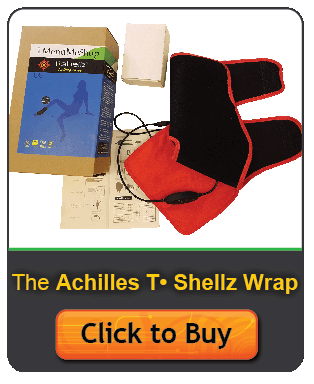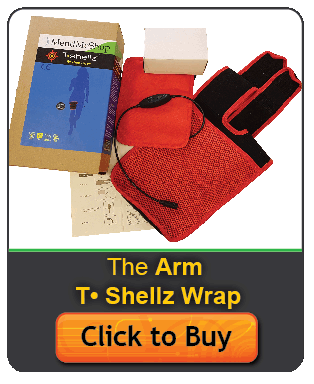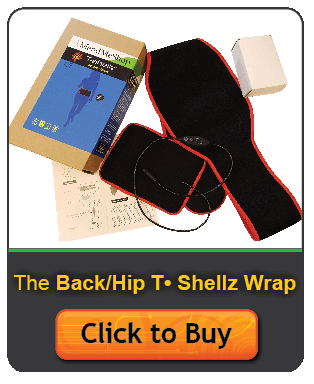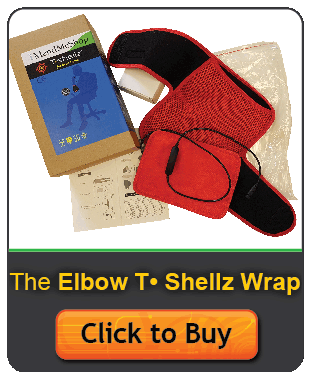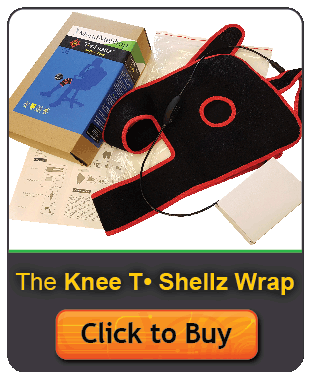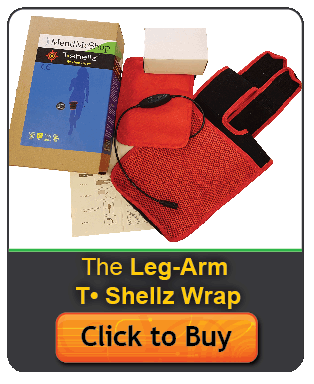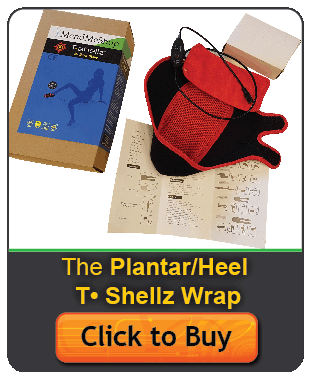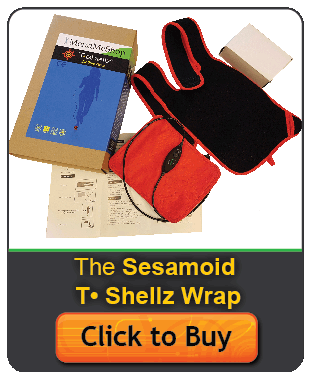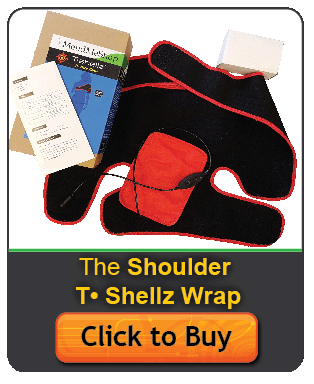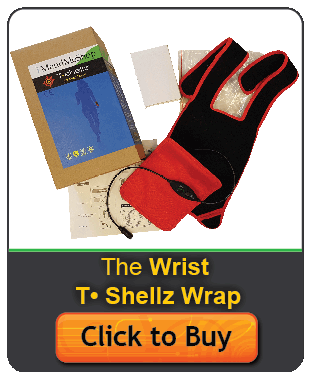Tendinitis, Tendinosis, or TenosynovitisAchilles TendinitisAchilles TendinosisThe term tendinosis refers to a non-inflammatory, degeneration of the collagen fibers in a tendon. This tissue break down is often caused by repetitive stress on the tendon fibers and the failure for the fibers to heal. In fact, the rate of tissue damage exceeds the healing process and eventually the build-up of damage on the Achilles tendon is not able to heal properly. The tissue (collagen fibers) degrade to a point where the once straight, strong, flexible bundle is weakened by abnormally formed fibers that look more like a mess of strands. Since there is no inflammation with tendinosis you will not experience swelling, heat or redness. However, you will experience pain, tenderness and stiffness at the back of the ankle where the tissue degeneration has occurred. This is the most common among Achilles tendon injuries. Achilles TenosynovitisTenosynovitis, (also called paratendonitis), is a term used to describe inflammation and degeneration of the tendon's outer layer or sheath. The Achilles tendon sheath is called the paratenon, which explains why the term paratenonitis has become a popular term for this condition as well. It is possible to suffer from tenosynovitis alone or in conjunction with the degeneration of the Achilles tendon (called Achilles tendinosis). As your body tries to heal, scar tissue forms inside the sheath attaching the inner tissues of the Achilles tendon to its outer covering (paratenon). This scar tissue limits the gliding movement of the tendon, reducing the range of motion and causing pain, tenderness, redness, and swelling. Achilles Tendinopathy TreatmentsIf you have an achilles tendon injury, rest is recommended, however, some careful movement is required to prevent the joint from freezing and losing range of motion. See your doctor or physical therapist for stretches that will not cause further injury to your achilles. Avoid activities that cause pain or may have caused the injury and begin cold compression treatments as soon as possible.  The Achilles tendon is a difficult tendon to rest completely as it is an essential tendon for walking and daily activities. Fortunately, there are tools that can help boost blood circulation in to Achilles region, strengthening the ability of the body to heal soft tissue. We feel this can help you get back to a life without pain and risk of further injury. The use of a TShellz Wrap® (Circulatory Boost) increases elasticity of soft tissue while promoting blood flow (vasodilation) at the treatment site. Although steroid injections may provide temporary relief from the pain of an achilles injury they should generally be undertaken with caution as they weaken the tendon and may lead to a complete rupture. If you do opt for an injection, doctors usually recommend that you do not participate in strenuous activities for several weeks to reduce the risk of a rupture. Conservative Treatment Step 1: Reduce The Initial InflammationInflammation is the body's natural response to an immediate achilles injury and is a normal part of the healing process - helping to reduce tissue infection in the early stages of injury. Swelling, pain, heat sensation, redness, and loss of function are the main symptoms experienced. The combination of rest, topical pain relief cream and minor amounts of cold is the gold standard in medicine for minimizing tissue damage and reducing inflammation after injury or activity. It serves as a critical bridge into the next phase of the healing process. Conservative Treatment Step 2: Enhance Blood Flow to the Injured Soft TissueOnce the inflammation in your Achilles tendon has been reduced, nourishing and strengthening the tissue in the Achilles tendon and surrounding area is recommended. When you have a tendon injury, there is not much blood flow in your injured tendon, especially if it is in the watershed zone, which it probably is. Inflammation and reduced movement (lack of activity or on-going immobility) reduces the flow of blood to an area that is already receiving very little blood flow. If you are moving your injured Achilles around you run a risk of increasing the severity of the injury. If there has been some healing, you could re-injure your tendon all over again. Even though the concept is simple, improving blood flow to injured tissues can be difficult. When the injury is ankle related, the challenges are even greater. Traditional methods require your muscle to move to promote blood flow (exercise), but that same motion that promotes blood flow can at times lead to making your pain and condition worse.
Most people we deal with tell us these scenarios have happened to them many times in the past. Perhaps it has already happened to you. Promoting blood flow within a muscle or soft tissue injury to help the body heal itself is a concept that has been utilized for centuries. This is where the focus has to be if you are seeking long-term improvement. Oxygen and nutrients, carried within the blood, are critical for the body to heal itself. Without proper blood flow, recovering from an injury or condition will be delayed...sometimes for a very long period of time. The real challenge is how do you promote blood flow to the tendon without causing further injury? This goal is further complicated by the fact the achilles (and muscles controlling the ankle joint) are involved in the majority of the physical movements we perform each day. It is through the blood the body carries the nutrients and oxygen that injured tissues rely on for recovery.. It is well known that increased blood flow helps your body accelerate the healing process. This is why the TShellz Wrap®is such an important tool. The whole purpose of the wrap is to provide localized heat while also significantly increasing blood flow to tissue in the treatment area. The result of this is as follows:
Increased Blood Circulation = Increased Healing CapabilityTShellz Wraps® contain a unique Carbon Fiber Energy Pad which is flexible and will shape to conform to your body. This Energy Pad emits a uniform wave of perfectly safe energy over its entire surface. This energy is absorbed by soft tissue in the treatment area, opening blood vessels, resulting in an increase in blood flow. Increased blood circulation is what your body needs to accelerate the healing of soft tissue and this is why we recommend the TShellz Wrap®. The Achilles TShellz Wrap® is an FDA Registered Medical Device and is suitable for use in therapeutic clinics and FROM HOME. It is completely safe for people and patients to use for themselves. The technology found in a TShellz Wrap® has been used for decades in the worlds of professional and amateur sports - a contributing factor as to why athletes seem to recover from injuries so quickly. Have you ever wondered by an athlete can return to activity after 3 to 6 weeks following a foot injury - while your average person takes much longer to return back to normal? The secret isn't really that much of a secret - it involves consistent treatments (meaning multiple times a day) using a treatment like the TShellz Wrap® to stimulate blood flow to the injured tissues. Most athletes have the luxury of using in-house facilities many times per day. How many us can afford the time and money to visit a clinic multiple times a day? Very few indeed. This is how you can gain some of the advantages that athletes enjoy in their injury recovery - by using a device like the TShellz Wrap® two or three times a day on a consistent basis. Consistent Treatments = Consistent And Long Term ImprovementWhat Else Makes the Achilles TShellz Wrap® So Special?We believe the TShellz Wrap® to be one of the most effective home treatments to increase localized blood flow to soft tissue in and around the treatment area. We can promise that you will receive a product that is designed to be safe and does what it is supposed to do... reduce pain (as stated in "Therapeutic Heat and Cold", 4th edition. - Ed. Justus F. Lehmann, M.D., Williams, and Wilkin) temporarily increase length & flexibility of soft tissue (as stated in "Therapeutic Heat and Cold", 4th edition. - Ed. Justus F. Lehmann, M.D., Williams, and Wilkin) and aid your body in recovering from tendon, muscle and other soft tissue injuries via enhanced blood flow. 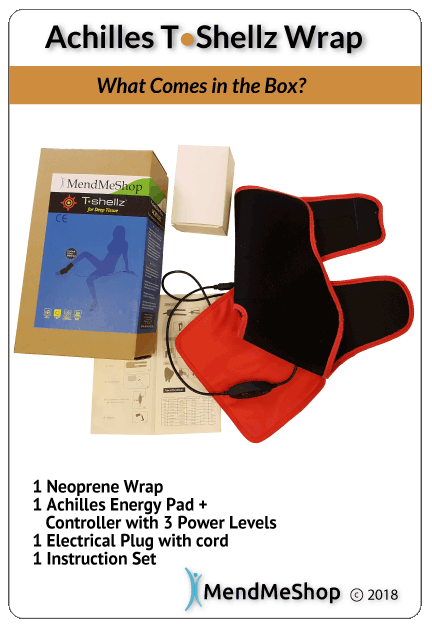 The unit plugs into a standard wall outlet to get its power. The nice thing about the power supply is that the same unit can be used in North America and overseas as well. It has the capability to operate between 110v and 230v. The TShellz Wrap® has a special signal controller that can be set for 3 different power levels of application (3=High, 2=Medium, 1=Low). The cord is long enough that you can sit or lie comfortably and watch TV, read or surf the net while you're using it. Treatments are max 30 minutes in duration and the device can be worn over clothing. This allows you to use the device at work, at home, or really anywhere you have access to an electrical outlet. Conservative Treatment Step 3: Recognize That Healing is a ProcessWith dedication, the right tools, and the right information - you will achieve your goal of a sustainable recovery. A combination approach of cold, deep heat treatments, and functional movements will make it happen much more quickly. In our experience, soft tissue repair rates via conservative home treatment methods using a dedicated, comprehensive approach have surprised many of our clients, but will differ from person to person. In nearly all cases, however, it is very important to stop whatever you were doing that created the injury in the first place (ie. running, jumping, climbing stairs). The Achilles TShellz Wrap® - A Healthy Achilles For The Long TermThe best option we came across in our research to accomplish effective blood flow to soft tissue in the achilles area at home is the Achilles TShellz Wrap®. Use of this device results in an increase of blood flow within the treatment area - all in a non-invasive manner. Have you seen what happens when you add water to a flower wilted from drought? In essence, your injured achilles is much like a "wilted" flower; your body wants to heal its injury, but needs lots of nutrients to do it. Blood brings life to your tissue by delivering healing nutrients and oxygen that are vital for their growth and survival. In addition, the blood carries away toxins and waste cleaning the area and healing it faster. Without a good supply of blood, your achilles simply won't heal properly. Using a TShellz Wrap® will not expose you to the risk of causing further harm to soft tissue like you can when using rigorous exercise. The Achilles TShellz Wrap® accomplishes the goal of enhanced blood flow without the need for intensive exercise and as such reduces your risk of re-injury. Conservative Treatment Tools Our Clients Have Used to Help |

Achilles Tendon Facts There are over 250,000 achilles tendon injuries each year in the US. Achilles tendon ruptures are common in people between the ages of 30 and 50. In runners, too rapid an increase in mileage, hill training without proper strengthening, and recent or inadequate changes to running gear can cause injuries to the Achilles tendon. Achilles tendonitis accounts for an estimated 11% of running injuries. 3-5% of athletes are forced to leave their sports career due to Achilles tendon overuse injuries that go untreated. Medications mask the pain but do very little in the healing of Achilles tendonitis. A fully ruptured tendon REQUIRES surgery. It will not heal on its own. Achilles tendonitis and Achilles tendinitis are the same thing. Continually using your Achilles tendon while it is injured will lead to a more serious and/or chronic injury.  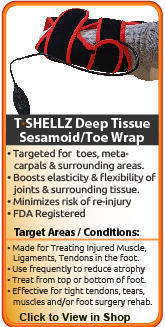        |



